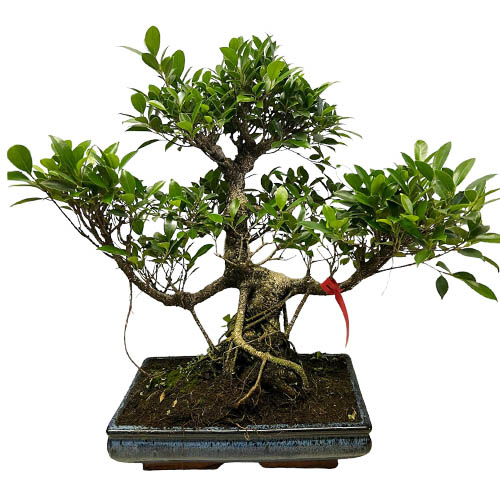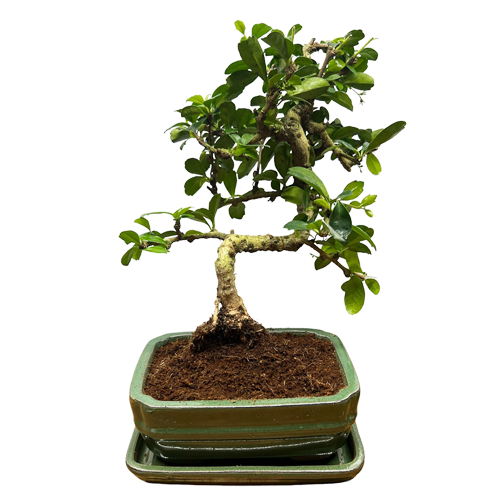Bonsai Plants Indoor: Attractively Display Your Indoor Bonsai Tree
Choosing an indoor bonsai tree can seem daunting as there are a range of indoor bonsai trees. Yet tropical species like ficus (with its robust nature and forgiving disposition), Schefflera (also known as the umbrella tree), or the glossy-leaved Carmona can make this a joyous and rewarding endeavour. The sturdy structure of the Chinese elm makes it another great choice, and the splendid dwarf jade is perfect for those seeking a beautiful interior house plant. These specific varieties are more resilient when it comes to the drier and warmer conditions found in our homes. By ensuring they’re placed in spots that receive plenty of indirect sunlight and perhaps employing a humidity tray with pebbles, we can provide an optimum environment for bonsai trees to prosper as house plants.
Creating a small slice of nature within your home through the cultivation of indoor bonsai trees isn’t just about beautifying the space, it’s about tending the tree’s need with specific care and seeing it thrive under our careful attention. As we tend to these miniature masterpieces, we learn the art of patience and the joy that comes with nurturing life, right on our windowsills.
Key Takeaways
- Tropical and subtropical bonsai species such as ficus, jade, and Chinese elm can adapt well to indoor environments.
- Adequate light, humidity, and warmth are essential for the health and growth of indoor bonsai trees.
- Utilising humidity trays with pebbles and placing bonsai in bright areas with indirect sunlight helps ensure their vitality indoors.
Ficus Bonsai

Ficus bonsai trees, with their glossy leaves and impressive aerial roots, make a striking feature in any indoor space. We’re all about the lush, evergreen charm these trees offer. They’re more than just ornamental; they bring a touch of the tropics right into our homes.
The Ficus species make up a varied selection of indoor bonsai trees. Ficus benjamina, often known as the weeping fig, which is a real crowd-pleaser with its arching branches. Then there’s the robust Ficus retusa with its thick, trunk and the Ficus microcarpa, famed for its distinctive ginseng-like roots.
Here’s a nifty little care guide that we swear by:
- Watering: Keep them quenched! We water ours when the topsoil feels dry, but we’re careful not to overdo it.
- Feeding: A little snack of fertilizer during the growing season keeps them happy.
- Pruning: We snip away to maintain shape and encourage growth, preferably in winter.
- Repotting: As they grow, we give them a new home every couple of years.
But sometimes things get tricky. Leaf drop can be a tantrum thrown by our ficus if they’re not happy with their location or if we’ve been a bit too enthusiastic with the water can. Pests? They sometimes invite unwanted guests like aphids or mealybugs, that need showing the door with gentle insecticides.
We’ve found these resilient trees are mostly cooperative, but we keep an eye out for common issues and tackle them as soon as they crop up. With a bit of care and attention, our Ficus bonsai thrive, making our indoor garden a tranquil green haven.
Chinese Elm Bonsai

The Chinese Elm Bonsai with its small, bright green leaves and corky bark just announces character. It’s not just us that finds these miniature trees a bundle of joy – they’re essentially the crown jewels of the bonsai world for many and make an ideal bonsai gift. Yet they’re especially good for us green-fingered enthusiasts just starting out.
So, why are they such hot favourites? Well, these little beauties are quite the tough cookies. They’re versatile and forgiving, not throwing a tantrum whether you keep them indoors or let them bask outside.
Taking care of a Chinese Elm is quite simple:
- Watering: They don’t like to be thirsty, so let’s keep the soil moist, but never waterlogged.
- Fertilizing: A bit like us needing a varied diet, your bonsai needs a good fertiliser come growing season.
- Pruning: Keep those shears handy. Trimming helps maintain their adorable shape.
- Repotting: They enjoy a change of scenery (pot) every couple of years; it keeps them sprightly.
We might run into a few hiccups along the way. Leaf burn can happen if we let them sunbathe too much. And, if they drop their leaves suddenly, don’t panic; it’s just their way of saying they’re stressed. A bit of TLC will sort that out. Should a fungus decide to visit, we’ve got to show it the door quickly with some fungicide.
Remember, the key to a happy Chinese Elm Bonsai is balance and attentive care. Just like us, a bit of love and the right environment can make all the difference to their well-being. So, let’s roll up our sleeves and give these exquisite little trees the care they deserve!
Carmona Bonsai

Carmona bonsai are charming little trees, also known affectionately as Fukien tea or Chinese tea, and are a pure delight for indoor gardeners. Not only do they grace our spaces with lush, dark green leaves, but their white flowers and bright red berries add a burst of colour that captures the heart of any plant lover.
When caring for our Carmona bonsai attention and love make all the difference. These little trees enjoy a good drink, but remember, consistency is key. We aim to keep the soil moist but never waterlogged. Overwatering can lead to the dreaded root rot, so let’s be vigilant.
Here are some vital care tips for Carmona Bonsai:
- Watering: Keep soil consistently moist
- Fertilizing: Feed regularly, especially during the growing season
- Pruning: Trim to maintain shape and encourage dense growth
- Repotting: Perform every two years to ensure healthy roots
You may notice a few leaves turning yellow or dropping, it’s a common hiccup for these bonsai. Often it’s just a reaction to a change in the environment, so make sure to keep things stable. Also, keep an eye out for uninvited guests like pests, but with proper care, our bonsai will stay happy and healthy.
As we tend to our Carmona bonsai, remember, it’s not just about the routine; it’s about the moments we create while nurturing these miniature trees. They’re not only pieces of living art but companions that grow alongside us.
Jade Bonsai
Jade bonsai trees with elegant leaves and robust trunks, can be perfect for beginners. Portulacaria afra, commonly known as mini Jade, and Crassula species like Crassula ovata (classic Jade) and Crassula arborescens (Silver Dollar Jade), exhibit gorgeous small flowers and a quaint, serene presence.
Caring for these charming little jade trees is a joy. Let’s remember that they thrive on minimal water – just enough to keep the soil slightly moist but not soggy. Fertilizing? Only in the growth season and sparingly. Now, pruning is where we can get creative! Snip away to maintain shape but be considerate; these are slow growers. Repotting isn’t too frequent a task, thankfully, about every two to three years should suffice.
Here’s a brief list of simple care tips for our Jade trees:
- Watering: Wait for the soil to dry out before watering.
- Light: They fancy a spot with loads of sunlight, full beams if you can manage.
- Temperature: Shield the little fellas from the cold; anything lower than 5°C is a no-no.
- Pruning: Encourage a sturdy shape with considerate trimming.
Be mindful of overwatering as it can risk root rot, so be sure to not drown them. Sunburn is also a risk so a spot with diffused sunlight is ideal. Just roll with these tips, and we’ll have healthy, happy Jade bonsai.
Schefflera Bonsai
Also known as the Hawaiian umbrella or dwarf umbrella tree, Schefflera bonsai is ideal for beginners. Its unique umbrella-shaped leaves and glossy stems can surely turn your indoor space into a petite tropical haven. These little beauties aren’t just captivating; they’re also known for their resilience and low maintenance, making them an ideal choice for both novices and bonsai enthusiasts alike.
Caring for our Schefflera bonsai is quite straightforward. Here are our top care tips:
- Watering: Keep the soil evenly moist but not waterlogged. It’s best to water your bonsai when the topsoil feels dry to the touch.
- Fertilising: During the growing season, use a balanced liquid fertiliser once a month to keep it healthy.
- Pruning: Regular pruning will maintain the shape of your bonsai and encourage new growth.
- Repotting: Every couple of years, give it fresh potting soil and consider a larger pot if necessary.
We sometimes face common issues such as leaf loss, which is often due to overwatering, and root rot, which can be prevented by ensuring good drainage. If you spot scale insects, a gentle wipe with soapy water or an appropriate insecticide does the trick. Remember, aerial roots are part of their charm, and with a bit of patience, we can train and style our Schefflera bonsai to thrive in our living room.
Important: Pest Control For Your Indoor Plant
Lastly, keeping pests at bay ensures our bonsai remains a thing of beauty. We’re on the lookout for any signs of infestation, using natural predators or insecticidal soap to keep the pests at bay. A healthy bonsai is less susceptible to problems, so we give our trees the best care to prevent issues from arising.
Easy Indoor Bonsai Trees – Ideal for Beginners
In nurturing our indoor bonsai trees, we’ve journeyed through the essentials: from selecting the right kind of tropical or subtropical species to ensuring they bask in ample warmth and light. Remember, choosing a well-lit position away from direct sunlight and providing sufficient humidity is paramount.
Let’s not forget the significance of watering and pruning, both of which contribute to the health and aesthetic of our miniature trees. Moreover, embracing the right tools and techniques can make the process far more enjoyable.
By sharing knowledge and experiences with fellow bonsai admirers, we deepen our understanding and enhance our skill set. Let’s keep fostering the serenity that these miniature marvels bring into our homes. Happy cultivating!
FAQs
We’ve rounded up some top questions to help you get wise about those trendy mini-trees, the indoor bonsai, so you can give ’em a proper go without a stitch of bother.
Ficus, Chinese Elm, or a lovely Chinese Privet are your best bets. They won’t grow into a towering jungle beast in your lounge and are fairly easy to manage.
A south-facing window is ace as it’s the brightest spot, but avoid letting the strong sun beat down on your little tree friend all day. If it’s too dim, like with a north-facing window, the tree might throw a strop by growing weak
Many reckon that bonsai trees bring peace and luck into a home. Plus, they’re a doddle to chat with if you’re feeling lonely. Just be careful not to natter away too much, or your mates might think you’ve gone round the bend.
Feel free to look around our online store for a young plant that’s easier on the pocket. All species for sale at Miyagi Bonsai come with care guides and specific instructions to tend to all skill levels.
Start with a robust type like the Ficus, which is more forgiving if you muck up. Get clued up on the basics: right amount of water (not too much, not too little), decent light, and don’t forget to primp those leaves and branches.
Leave the cuppa for yourself. Your bonsai fancies a special feed, usually found at garden centres. Stick to the feeding guide, so your bonsai doesn’t end up overfed and poorly.
